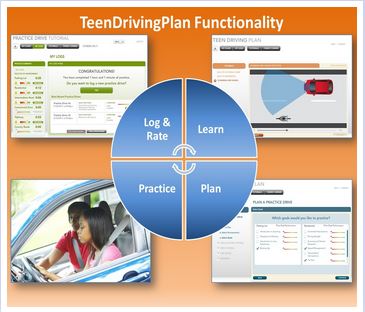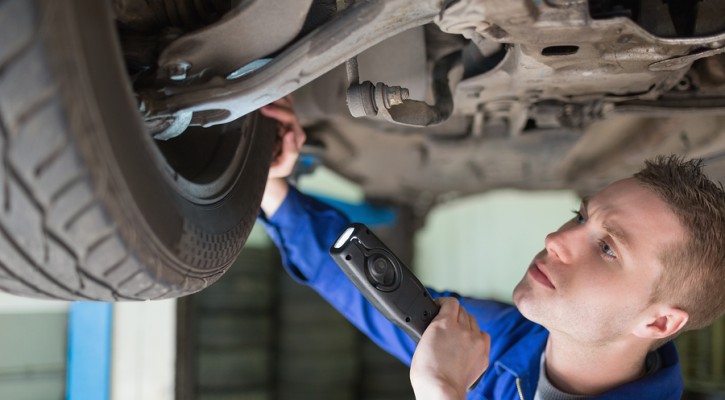Tag Archive: safe driving

“Teen Driving Program” Improves Teen Driving Performance
July 8, 2014
A study released recently by the Center for Injury Research and Prevention at the Children’s Hospital of Philadelphia (CHOP) showed that the experimental Teen Driving Program (TDP), a web based program that helps parents plan and track their teen’s progress while learning to drive, significantly improved driving performance for teens. The study tracked two groups of teens, one that used the TDP program and one that didn’t. According to the study results:
- “Young drivers that used TDP over a 24-week period were 65 percent less likely to fail a rigorous on-road driving assessment than those not given access to the intervention.
- Overall, six percent of teenagers that used TDP had their on-road driving assessment terminated due to unsafe driving performance as compared to 15 percent of those not given TDP.
- Families who used TDP also reported more driving practice in various environments, at night, and in bad weather.
- TDP increased parent engagement as practice supervisors, practice variety (at least 1-2 hours of practice in all six driving environments), and parent support of teens.”
The program isn’t available to the public yet but, according to a news release put out by CHOP, it will be available later this year. For a video demonstration of the program and to learn more, read: TeenDrivingPlan (TDP)
Photo compliments of: Children’s Hospital Of Philadelphia

Ask The Driving School Instructor: Most Important Vehicle Control Device
June 24, 2014
Question: I saw a question that asked “What is the most important control device on a car or vehicle?” but I couldn’t find the answer. What is the most important control device?
Answer: Most people would answer the steering wheel or gas and brake pedals but none of those items are very effective at controlling a car if the tires aren’t in contact with the road. The tires are actually the most important control device on the car.
That portion of the tire that is in contact with the road is known as the tire’s “footprint.” The larger the footprint, the more control you have over the vehicle. If you are speeding, there’s an aerodynamic force on the car that makes the rear end rise up off the road, decreasing the tire’s footprint. If you should encounter a curve or an obstacle in the road, the smaller footprint could cause you to lose control of the car.
When driving on gravel roads, your tire’s footprint is even smaller because it is only in contact with the tips of rocks instead of the solid footprint that would be experienced on a paved road. It’s much easier to lose control of a vehicle on a gravel road so maintaining a lower speed is very important.
In heavy rain where there is standing water on the road, your tires may not be able to squeeze out all the water through the openings in the tread. In this situation, known as “hydroplaning”, the tires can ride up on top of the water like a water ski. In a hydroplaning situation, your tires will lose all contact with the road’s surface and you will lose control of the car. Hydroplaning can start at speeds as low as 35 mph but is more common at speeds above 55 mph. If you see standing water on the road, you should slow and keep a firm grip on the wheel. If you should hydroplane, don’t hit the brakes! Instead, take your foot off the gas and steer the car in the direction you want it to go until the car slows on its own.
It’s also very important to make sure the tires on your vehicle are in good shape and inflated to the proper pressure. If they are bald, they won’t be able to grip the road very well. The best way to tell if your tires are in good shape is to use the penny test. Stick a penny into the tread of the car. If you can see the top of Lincoln’s head, your tires are worn too low and should be changed.

Ask The Driving School Instructor: Most Dangerous Type Of Road
June 3, 2014
Question: What is the most dangerous type of road to drive on?
Answer: Most people assume, because of the high speeds involved, that interstates or freeways are the most dangerous type of road but they aren’t. The most dangerous type of roads for all drivers but especially for teens are two-lane country or rural roads. Fifty-seven percent of teens killed in traffic crashes die on rural roads.
The reason that rural roads are so dangerous is that they are usually narrow and tend to curve and wind and can also be hilly. These types of roads leave very little room for escape in an emergency. At night they can be especially dangerous because it is hard to see curves or other hazards ahead.
Often drivers drive too fast on these roads and, even though there are usually signs pointing out a curve ahead, they enter the curve at too high a speed and can’t keep the car on the road. If a driver is distracted and drives off the side of the road, there is usually little or no room to recover. Drivers also can become frustrated when stuck behind slower vehicles ahead and that may lead them to take stupid chances such as passing in a no-passing zone where they can’t see the road ahead.

Help Your Teen Become a Better Driver
December 26, 2013
In a recent AAA article, it has been examined that parents who ensure that their teens receive enough practice are more likely to help their teens become safer drivers. Also, though quite unrelated driving, AAA feels that parents who spend more time with their teen drivers prior to them driving on their own also effectively aide in their teens’ driving abilities.
Here at Lowest Price Traffic School, we also place a great deal of emphasis on parental involvement in teen driving. With editionslike Driver Education Handbook for Parents, as well as our Parent Taught Teen Driving course, we help parents more effectively guide their teens into becoming advanced early drivers.
“Unfortunately, teens still have the highest crash rate out of any age group, so it is critical for parents to be involved and use evidence-based techniques that work,” said Dr. William Van Tassel, AAA Manager of Driver Training Programs. “These recommended coaching techniques may seem rather obvious, yet research findings show that parents aren’t regularly practicing these techniques.”
A recent study that surveyed parents and teens during the process of learning to drive found that:
- Nearly half of parents reported that they wanted their teens to get “a lot of practice,” when asked about their teens’ driving skills. Only about one in four parents mentioned practicing in a various situations or conditions, such as bad weather, heavy traffic, or on unfamiliar roads.
- Roughly 47 percent reported that they have not allowed their teen to drive in an unsupervised area, even if they have passed their driving test and received their license.
- Relatively few parents were observed imparting rare driving tips to their teens – such as visual scanning or anticipating other drivers’ behaviors.
Parents should ultimately make sure that their teens receive ample driving practice, which goes beyond getting practice on routine trips on familiar roads. The apparent thought here is that teens will be much more competent drivers, or at least more attentive, in a relatively unfamiliar setting.
If you are looking to bolster your teenager’s driving abilities, then our courses are ideal for you! At Lowest Price Traffic School, we are proud to foster this idea of parent-lead teenage driving safety, and is why we created the programs in the first place. Your children already look to you to learn the rest of life’s lessons, but unlike a few lessons that come from their own personal experiences, the more knowledge you throw their way, the better they will retain the information!
How’s My Driving Decals
July 14, 2011
You’ve seen one of them: decals that ask the question: “How’s my Driving?” These used to be more common for trucks, cabs or other public service vehicles — now, several services have popped up that have expanded on the functionality of these decals into letting parents know if their teen drivers are doing a good job of driving.
Here are some of those services:
Teen Road Angel (www.teenroadangel.com) – From their name itself, they are immediately announcing that their focus is towards teens. Upon availing of a membership ($40 annual fees, $20 for additional driver), a specialized decal is created for the driver. When someone calls the number on the decal, a notification is sent to the parent via email, text message or voice mail. They are currently working out deals with insurance companies to hopefully provide discounts for availing of their decals.
JustReportIt (www.justreportit.com) – JustReportIt, the cheapest service in this list comes at only $20 for the first year, and $10 for each renewal. They have achieved this price point by requiring the report entry online-only. There is no special number to call, but relies on people to take note the specialized code assigned to the decal and have them enter it on the report page on their site. While not specifically focused for teens, businesses may also avail of their services and even get their decal customized with a company logo.
